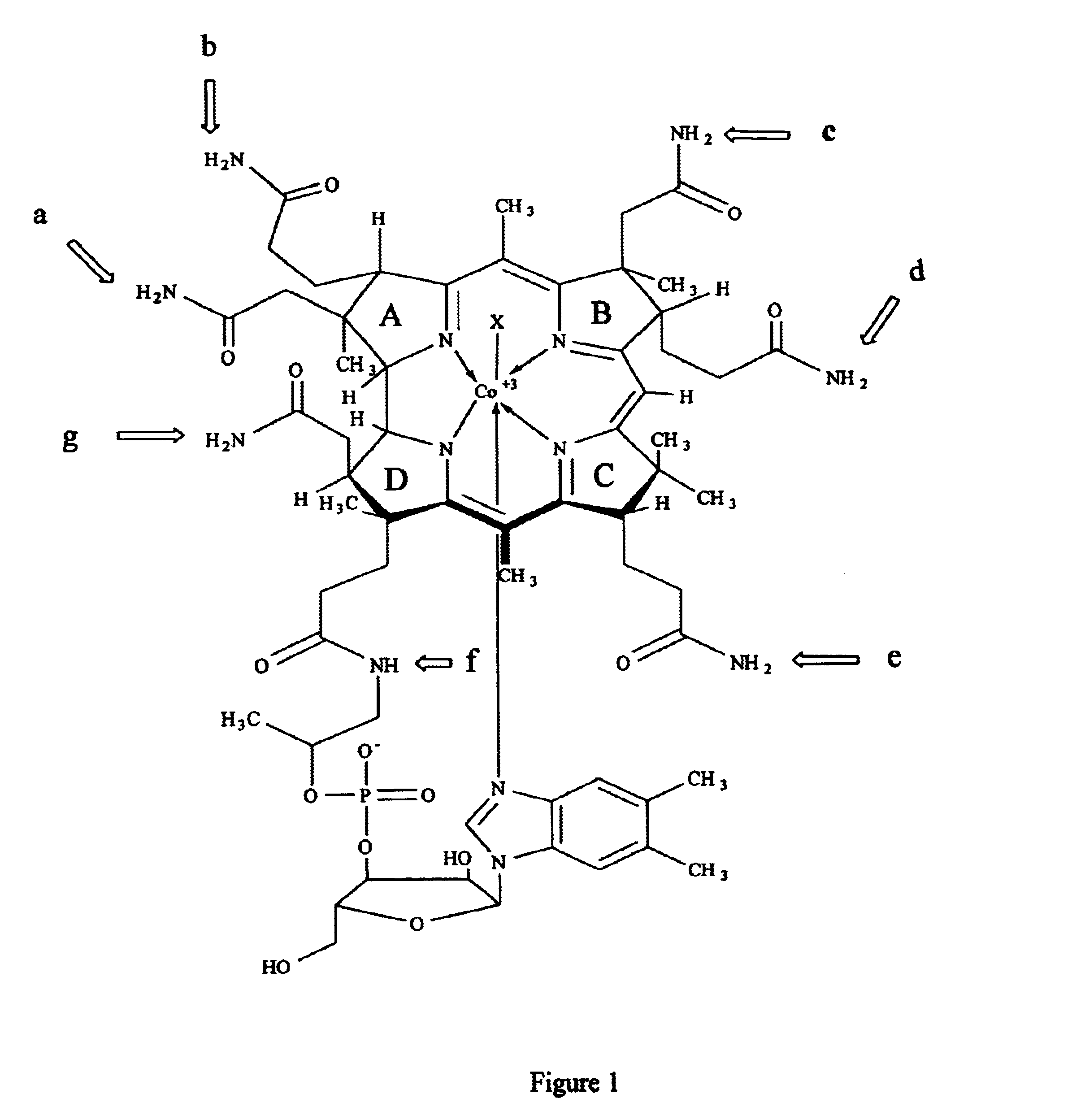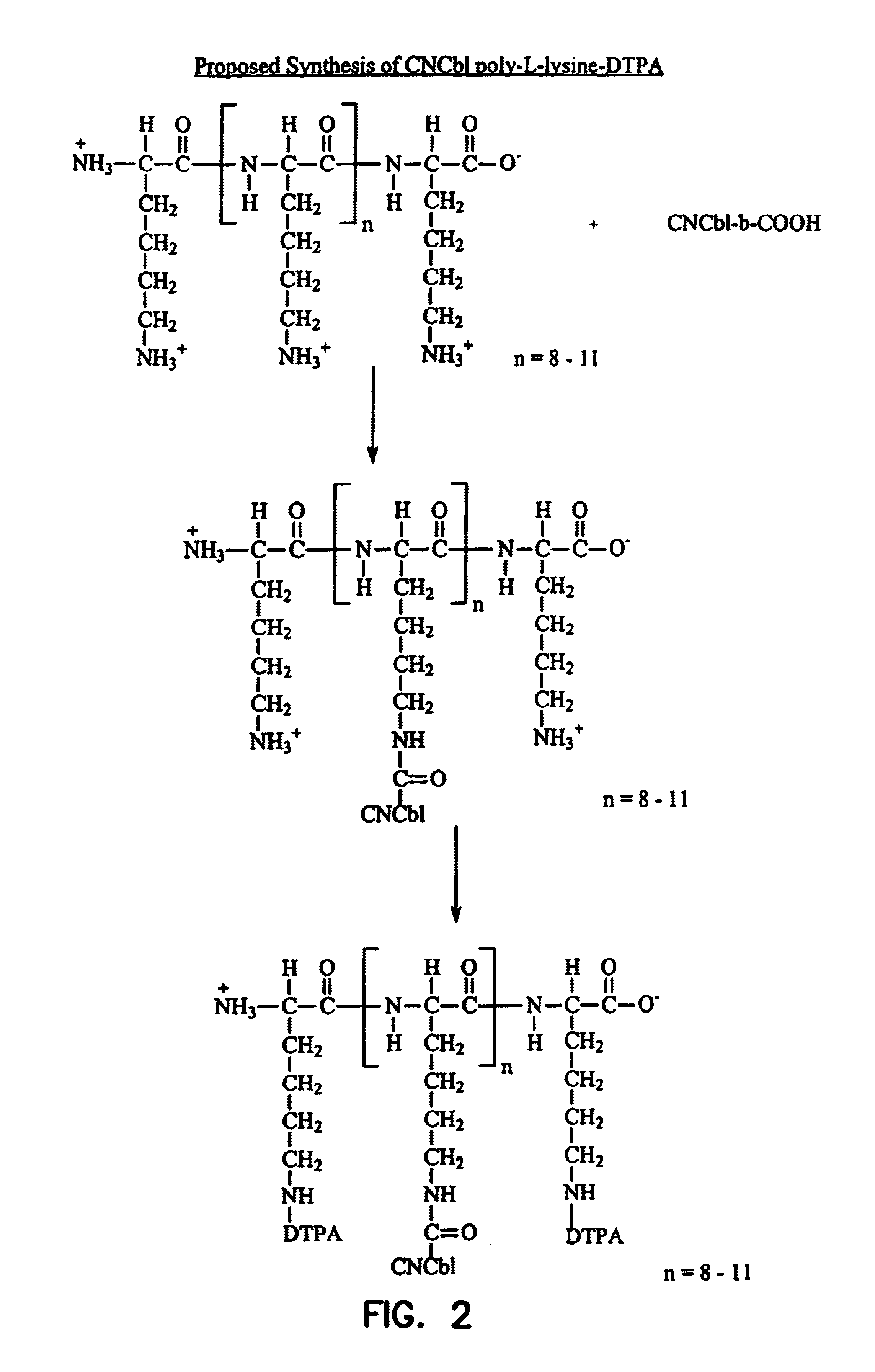Cobalamin conjugates useful as imaging and therapeutic agents
- Summary
- Abstract
- Description
- Claims
- Application Information
AI Technical Summary
Benefits of technology
Problems solved by technology
Method used
Image
Examples
example 1
Cyanocobalamin-Poly L-Lysine-DTPA Conjugate Poly-L-lysine hydrobromide (Sigma no. PO879), degree of polymerization ˜11 units, molecular weight range 1000-4000 (500 mg) was dissolved in water (20 ml). Cyanocobalamin-b-monocarboxylic acid (150 mg, ˜100 μmol), 1-ethyl-3(3′-dimethylaminopropyl) carbodiimide (480 mg, 2.5 mmol) and hydroxybenzo-triazole (338 mg, 2.5 mmol) were added. The pH of the mixture was adjusted and maintained at approximately 8 with 1N sodium hydroxide. The progress of the reaction was monitored by thin layer chromatography on silica gel sheets using isopropanol-ammonium hydroxide-water (7:1:2) as the developing agent.
Upon completion of the reaction, the mixture was applied to a column of Sephadex G-10(3×40 cm). The column was eluted with water and 2 ml fractions were collected. The red eluents that reacted with ninhydrin were pooled and freeze dried (i.e., lyophilized).
Recovery of the cyanocobalamin-poly-L-lysine complex (about 70%) was obtained. The cyanocobalami...
example 2
Cyanocobalamin-Poly L-Lysine-DTPA Conjugate. Poly-L-lysine (Sigma no. 8954) degree of polymerization ˜8 units, molecular weight range 500-2000 (500 mg) was dissolved in water (20 ml). Cyanocobalamin-b-monocarboxylic acid (150 mg, ˜100 μmols), 1-ethyl-3 (3′-dimethylaminopropyl) carbodiimide (480 mg, 2.5 mmol) and hydroxybenzotriazole (338 mg, 2.5 mmol) were added. The pH of the mixture was adjusted and maintained at approximately 8 with 1N sodium hydroxide. The progress of the reaction was monitored by thin layer chromatography on silica gel sheets using isopropanol-ammonium hydroxide-water (7:1:2) as the developing agent.
Upon completion of the reaction, the mixture was applied to a column of Sephadex G-10 (3×40 cm). The column was eluted with water and 2 ml fractions were collected The red eluents that reacted with ninhydrin were pooled and freeze dried (i.e., lyophilized).
Recovery of the cyanocobalamin-poly-L-lysine complex (about 70%) was obtained. The cyanocobalamin-poly-L-lysine...
example 3
Imaging Data. In vitro unsaturated B12 binding capacity (UBBC) has demonstrated that cyanocobalamin-poly-L-lysine, cyanocobalamin-poly-L-lysine-polyDTPA compounds have in vitro biological activity that is 92% and 43.4% when compared to cyanocobalamin. Comparison of cyanocobalamin-DTPA to cyanocobalamin was 66.4% (Transcobalamin II receptor imaging via raiolabeled diethylene-triaminepentaacetate cobalamin analogs, J. Nucl. Med., 38, 717-723 (1997); also described in U.S. Pat No. 5,739,313). The specific activity has been increased from 300 μCi in the cobalamin mono-DTPA compounds to 4.5 mCi with the cobalamin poly-L-lysine-polyDTPA complex (D A Collins, H P C Hogenkamp, M W Gebard, Tumor Imaging Indium-111-labeled DTPA-adenosylcobalamin, Mayo Clinic Proceedings, 1999; 74; 687-691; Biodistribution of Radiolabeled Adenosylcobalamin in Humans, Review of 30 patents submitted to Mayo Clinic Proceedings). This should improve tumor-to-background ratio, which can be evaluated in murine tumor...
PUM
| Property | Measurement | Unit |
|---|---|---|
| Length | aaaaa | aaaaa |
| Metallic bond | aaaaa | aaaaa |
| Therapeutic | aaaaa | aaaaa |
Abstract
Description
Claims
Application Information
 Login to View More
Login to View More - R&D
- Intellectual Property
- Life Sciences
- Materials
- Tech Scout
- Unparalleled Data Quality
- Higher Quality Content
- 60% Fewer Hallucinations
Browse by: Latest US Patents, China's latest patents, Technical Efficacy Thesaurus, Application Domain, Technology Topic, Popular Technical Reports.
© 2025 PatSnap. All rights reserved.Legal|Privacy policy|Modern Slavery Act Transparency Statement|Sitemap|About US| Contact US: help@patsnap.com



